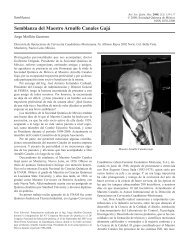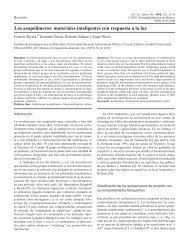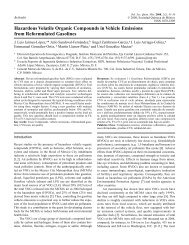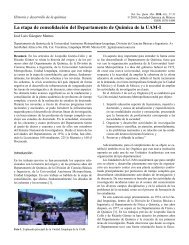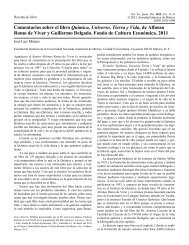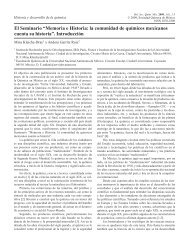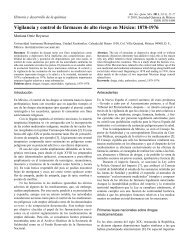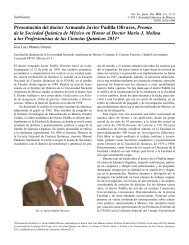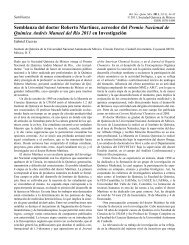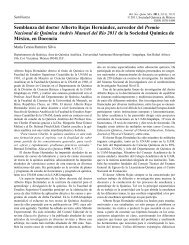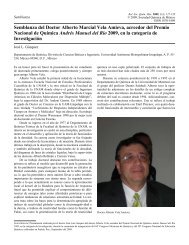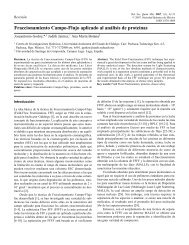A New Generalized Matrix Inverse Method for Balancing Chemical ...
A New Generalized Matrix Inverse Method for Balancing Chemical ...
A New Generalized Matrix Inverse Method for Balancing Chemical ...
You also want an ePaper? Increase the reach of your titles
YUMPU automatically turns print PDFs into web optimized ePapers that Google loves.
A <strong>New</strong> <strong>Generalized</strong> <strong>Matrix</strong> <strong>Inverse</strong> <strong>Method</strong> <strong>for</strong> <strong>Balancing</strong> <strong>Chemical</strong> Equations and their Stability 109<br />
Corollary 4.9. Let A∈. Then stab(A) < 0 ⇔ m(A) < 0 <strong>for</strong><br />
some Lozinskiĭ measure m on n .<br />
More results <strong>for</strong> stability criteria are obtained in works<br />
[142, 143].<br />
5. An Application of the Main Results<br />
In this section will be applied above method on many chemical<br />
equations <strong>for</strong> their balancing. All chemical equations balanced<br />
here appear first time in professional literature and they are<br />
chosen with an intention to be avoided to date all well known<br />
chemical equations which were repeated many times in the<br />
chemical journals <strong>for</strong> explanation of certain particular techniques<br />
<strong>for</strong> balancing of some chemical equations using only<br />
atoms with integer oxidation numbers.<br />
1º First we will consider an infeasible reaction, i. e., the<br />
case when the nullity of the reaction matrix is zero.<br />
matrix is one. Here we will balance many special chemical<br />
equations with a goal to show the power of the offered mathematical<br />
method.<br />
Example 5. 2. Consider this equation<br />
x 1 [4Yb(CN) 3·3Yb(CN) 2 ] + x 2 CsRu(CN) 2 F 2 (5. 2)<br />
+ x 3 CsRu(CN) 4 + x 4 CsHF 2 + x 5 [PtF 3·7H 2 O]<br />
= x 6 [Pt(NH 3 ) 2 (C 5 H 4 ON)] 2 (NO 3 ) 2·2H 2 O<br />
+ x 7 Cs 3.99 Yb(CN) 6 + x 8 HRuF 2.97 + x 9 NO 2 .<br />
From the scheme given below<br />
Example 5. 1. Consider chemical equation<br />
x 1 Fe 2 (SO 4 ) 3 + x 2 PrTlTe 3 + x 3 H 3 PO 4 (5. 1)<br />
= x 4 Fe(H 2 PO 4 ) 2·H 2 O + x 5 Pr 2 (SO 4 ) 3 + x 6 Tl 1.99 (SO 3 ) 3<br />
+ x 7 Te 2 O 3 + x 8 H 2 O.<br />
The reaction matrix<br />
2 0 0 -1 0.00 0.00 0 0<br />
3 0 0 0 -3.00 -3.00 0 0<br />
12 0 4 -9 -12.0 -9.00 -3 -1<br />
0 1 0 0 -2.00 0.00 0 0<br />
0 1 0 0 0.00 -1.99 0 0 .<br />
0 3 0 0 0.00 0.00 -2 0<br />
0 0 3 -6 0.00 0.00 0 -2<br />
0 0 1 -2 0.00 0.00 0 0<br />
is obtained from this scheme<br />
is derived the reaction matrix<br />
⎡ 7.00 0 0 0 0.00 0.00 -1.00 0.00 0 ⎤.<br />
⎢ 18.0 2 4 0 0.00 -10.0 -6.00 0.00 0 ⎥.<br />
⎢ 18.0 2 4 0 0.00 -8.00 -6.00 0.00 -1 ⎥.<br />
⎢ 0.00 1 1 1 0.00 0.00 -3.99 0.00 0 ⎥.<br />
A = ⎢ 0.00 1 1 0 0.00 0.00 0.00 -1.00 0 ⎥.<br />
⎢ 0.00 2 0 2 3.00 0.00 0.00 -2.97 0 ⎥.<br />
⎢ 0.00 0 0 1 14.0 -24.0 0.00 -1.00 0 ⎥.<br />
⎢ 0.00 0 0 0 1.00 -2.00 0.00 0.00 0 ⎥.<br />
⎣ 0.00 0 0 0 7.00 -10.0 0.00 0.00 -2 ⎦.<br />
The rank of the above matrix is r = 8. Since the nullity of<br />
the reaction matrix is k = n - r = 8 - 8 = 0, then we have only a<br />
trivial solution x = 0, that means that the reaction is infeasible.<br />
2º Next, we will consider the case when the chemical reaction<br />
is feasible and is unique, i. e., the nullity of its reaction<br />
The rank of the above matrix is r = 8. Since the nullity of<br />
the reaction matrix is k = n - r = 9 - 8 = 1, then we have a nontrivial<br />
solution x ≠ 0, that means that the reaction is feasible.<br />
Singular value decomposition of the matrix A is given by<br />
the expression A = USV T , where



